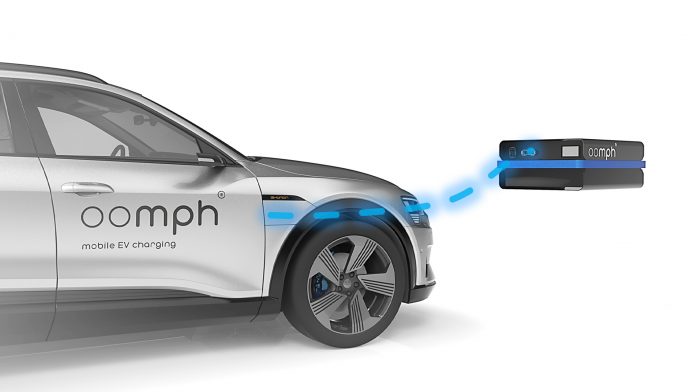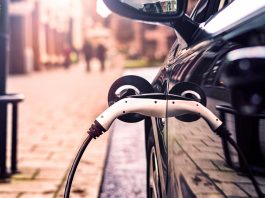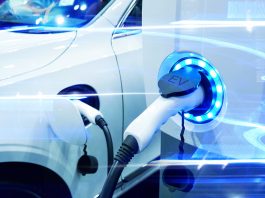A platform that offers rapid, mobile EV charging tech to allow anyone, anywhere, to have an EV charge service is launched by Cambridge start-up company, Oomph EV.
Oomph EV is set to offer the first mobile EV charging ecosystem, providing a customer-centric solution for rapid charging at a location of choice. This technology has been developed to plug an immediate gap in the EV charging infrastructure and provide the means for companies looking to deliver EV charging directly to customers.
In the age of convenience, it makes perfect sense that on-demand mobile charging will become an integral part of the EV charging network. Oomph EV are confident that their smart box charging tech will help deliver this. Capable of offering up to 50kW of rapid charge, the system is paired with an app-driven customer interface supported by backend data and energy management software.
By providing a complete mobile charging platform that provides convenience and tackles the fears and concerns surrounding EV ownership, Oomph believes their system can really help increase both EV adoption and provide a positive customer experience.
Range anxiety is still one of the leading barriers to electric vehicle ownership, even though the average driver’s current vehicle range capability is more than adequate. Whilst running out of fuel is certainly not a new concept, there is simply no quick fix solution available for the electric vehicle user. At best, you face recovery on a low loader to transport you to a fixed charging point, which is both time consuming and costly. This could be a nightmare situation for a family trying to entertain small children in the back seat or the logistics manager who needs to keep deliveries moving.
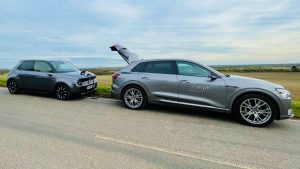
A service that comes to you
What makes Oomph EV’s offering so unique is the freedom it will ultimately provide the EV user whilst de-risking EV switch-over for individuals and businesses alike. A mobile service offering makes complete sense from your average EV driver wishing to request on-demand or pre-ordered mobile charging solutions through to the logistics manager under increasing pressure to make the switch to electric vehicles. By investing in Oomph’s ecosystem, business managers can continue to deliver in line with ever-demanding green policies whilst having the reassurance they are covered for the unplanned event that leads to zero miles range before a shift is over.
For Oomph EV, the goal is simple; to allow the EV user to decide when and where to receive a charge. Ranging from a top-up charge while out shopping, or parked at the station, a backup service for emergency zero mile recovery situations, or a convenient pre-planned top-up for the longer or more rural trips where fixed charging infrastructure is limited or plagued by unreliability; mobile charging can open up so many possibilities.
Future network challenges will include finding solutions for multiple EV car households where the option to charge overnight can only be utilised by one family member or the significant number of households who have no direct access to a permanent ‘at home’ charge unit. Mobile charging will become a helpful addition in both scenarios, helping to encourage further EV uptake.
Not only is Oomph EV here to disrupt the EV market, but its green credentials are also on point. Ecosystem users will be challenged to transport the smart box by EVs to the point of need, and system recharging will be completed with renewable energy to ensure a net zero mobile EV charging solution can be achieved.
The motivation behind Oomph EV
First-hand range anxiety, frustrations, and a belief that we can do better were the principle drivers behind creating Oomph EV and its smart box technology.
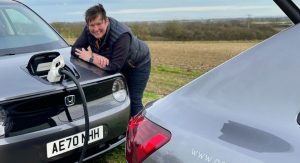
Having decided to take the EV plunge and invest in an Audi e-tron, Oomph’s founder, Morag Hutcheon, knows only too well the challenges that many EV users face daily, both from a personal and business viewpoint. The challenges started immediately with the first hurdle of a home charge installation which took a painstakingly long 12 weeks and resulted in numerous trips to the limited local charge points.
In the first three months of ownership, over 40 hours were spent camped out on, more often than not, slow fixed charge units to simply use the vehicle.
The typical euphoria experienced when purchasing a new car and new tech vanished rapidly, and was replaced with fraught journeys. The frustration of driving to two or even three sites for a top-up charge was compounded by the inconvenience of not being able to buy a coffee, arriving late to meetings or taking a comfort break at many of the poorly maintained sites. Oomph EV founder and EV user Morag Hutcheon, confirms that: “Driving was no longer a joy as frustration and range anxiety became a real issue.”
When you take these personal experiences and consider the impact on new EV sales or in a business environment where the downtime, missed deliveries and frustrations are amplified, it is no surprise business owners are nervous about making the switch. Battery technology, wireless charging, and EV infrastructure are improving. Many new players are adding weight to the efforts, but not fast enough to erase the fear and logistical challenges accompanying EV driving. Infrastructure expansion and continuous technology improvements are needed, combined with serious financial commitment from governments. In the meantime, mobile charging ticks a massive box in enabling a positive EV experience.
The smart mobile EV charging system
With a smart box charging solution capable of providing 40 miles range in just 12 minutes, and up to ten charge deliveries per working shift, Oomph’s mobile EV50 power unit will help dissolve range anxiety, drive forward ‘last-mile’ EV delivery solutions, and offer the convenience and flexibility that the modern consumer craves.
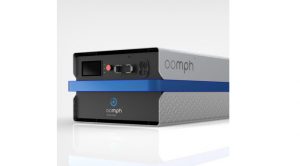
The Oomph EV technology is a complete ecosystem comprising both software and hardware.
At a basic level, the system contains a battery power pack with inverters and smart power electronics run by end-to-end software. The charge is uploaded from the grid using renewable energy supplies, transported in electric vehicles, and, as and when required, discharged to the customer’s EV. With three systems in the pipeline, Oomph EV is set to fill a much-needed gap in the marketplace.
Akin to a digital five-litre fuel can, the smaller 14kW has been designed for roadside recovery companies to get EV users back on the road, whilst the 35kW and 50kw charge systems are aimed at large service providers. These would include fleet management, last-mile delivery solutions and local authorities based in rural areas.
The aim is that service providers can deliver either top-up charges or more substantial amounts on a pre-order or on-demand basis. With the likes of Arrival pioneering the way for EV commercial vans, fleet operators can now realise the potential of switching to EV technology, safe in the knowledge that a solution exists to provide top-up charge ‘on the go’ to keep vans moving.
Who are Oomph EV?
Morag Hutcheon, a former winner of British Female Inventor of the Year and business partner Professor Phil Gray, are joined by a highly experienced product design and development partnership with significant global experience, well-versed in delivering excellence.
By harnessing 25 years of design, innovation and development expertise, Oomph EV has pooled their creative knowledge to develop a complete ecosystem with smart box delivery, to fill the much-needed gap in the current EV charging landscape: to provide a mobile EV charging solution, powered by green energy, at a convenient location to the customer.
Why Oomph EV? Well, that is simple. When faced with zero miles range, with a small amount of oomph, we get you moving.
The future for mobile EV charging
Oomph EV is genuinely leading the charge in mobile EV charging and are actively looking for partners to help accelerate the rollout of their technology.
Part of Cambridge Cleantech, and nominated for the longlist #21toWatch, there is a lot to be excited about for the Oomph team as we move towards 2022.
Please note, this article will also appear in the eighth edition of our quarterly publication.

